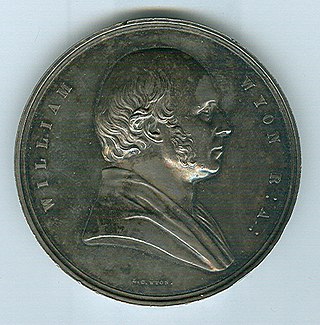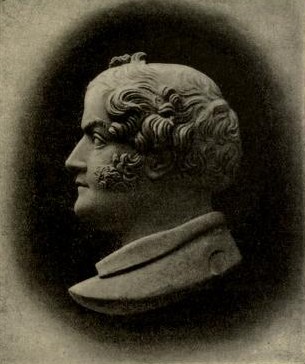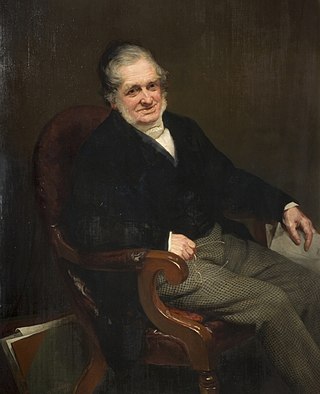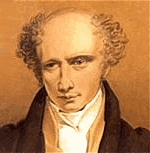Related Research Articles

The penny of Great Britain and the United Kingdom from 1714 to 1901, the period in which the House of Hanover reigned, saw the transformation of the penny from a little-used small silver coin to the bronze piece recognisable to modern-day Britons. All bear the portrait of the monarch on the obverse; copper and bronze pennies have a depiction of Britannia, the female personification of Britain, on the reverse.

William Wyon, was official chief engraver at the Royal Mint from 1828 until his death.

Benedetto Pistrucci was an Italian gem-engraver, medallist and coin engraver, probably best known for his Saint George and the Dragon design for the British sovereign coin. Pistrucci was commissioned by the British government to create the large Waterloo Medal, a project which took him thirty years to complete.
Thomas Wyon the Younger was an English medallist and chief engraver at the Royal Mint.

James Robertson (1813–1888) was an English gem and coin engraver who worked in the Mediterranean region, and who became a pioneering photographer working in the Crimea and possibly India. He is noted for his Orientalist photographs and for being one of the first war photographers.

Thomas Bock was an English-Australian artist and an early adopter of photography in Australia. Born in England he was sentenced to transportation in 1823. After gaining his freedom he set himself up as one of Australia's first professional artists and became well known for his portraits of colonists. As early as 1843 he began taking daguerreotypes in Hobart and became one of the earliest commercial photographers in Australia.

Allan Gairdner Wyon FRBS RMS was a British die-engraver and sculptor and, in later life, vicar in Newlyn, Cornwall.
George William de Saulles was a British medallist. He designed the obverse of coins of the United Kingdom and its colonies under Queen Victoria and King Edward VII.

Samuel Lines was an English designer, painter and art teacher, and an early member of the Birmingham School of landscape painters.

Leonard Charles Wyon was a British engraver of the Victorian era most notable for his work on the gold and silver coinage struck for the Golden Jubilee of Queen Victoria in 1887 and the bronze coinage of 1860 with the second ("bun") head portrait, in use from 1860 to 1894.
William Thomas Roden was a nineteenth-century English artist.

Allan Wyon (1843–1907) was an English medallist and seal-engraver.

Benjamin Wyon was a British engraver of seals, and medallist.
Thomas Wyon the elder (1767–1830) of the Wyon family was an English engraver of dies, who became Chief Engraver of the Seals.
Thomas Halliday was an English coin and medal engraver associated with the Royal Birmingham Society of Artists.

The Wyon family was an English family of traditional die-engravers and medallists, many of whom went on to work in prominent roles at the Royal Mint or as engravers in a family die business. Starting from Peter George (II) Wyon who migrated to England from Cologne, Germany many subsequent descendants of have made notable contribution to British numismatics. Over the course of the 19th-century two members of the family became Chief Engraver at the Royal Mint with many more involved in coin design.
Chief Medallist of the Royal Mint was a senior position at the British Royal Mint responsible for the overseeing of medal production. Historically the position was created in 1828 as a compromise to allow Italian engraver Benedetto Pistrucci to be more involved in the mint's engraving process without becoming the Mint's chief engraver. Being a foreign born Italian, appointment of Pistrucci to the prestigious role of Chief Engraver would have proved too scandalous and therefore despite performing the duties of chief engraver he was awarded the title of Chief Medallist. The role of Chief Engraver previously held by Thomas Wyon was awarded to his cousin William Wyon who along with Pistrucci were required to share the wages of both the Chief Engraver and second engraver, much to their disliking. In his role of Chief Medallist, Pistrucci was left feeling bitter at the injustice against him, producing little work of note apart from his Waterloo Medal.

Jubilee coinage or Jubilee head coinage are British coins with an obverse featuring a depiction of Queen Victoria by Joseph Edgar Boehm. The design was placed on the silver and gold circulating coinage beginning in 1887, and on the Maundy coinage beginning in 1888. The depiction of Victoria wearing a crown that was seen as too small was widely mocked, and was replaced in 1893. The series saw the entire issuance of the double florin (1887–1890) and, in 1888, the last issue for circulation of the groat, or fourpence piece, although it was intended for use in British Guiana. No bronze coins were struck with the Jubilee design.

Joseph Moore was a British medallist.
References
- 1 2 Flynn, Brendan (2014). RBSA: A Place for Art: The story of the Royal Birmingham Society of Artists. Liverpool: Callprint. pp. 52, 24.
- ↑ "Biography for Peter Wyon". Birmingham Museums and Art Gallery. Retrieved 22 June 2015.
- ↑ Kenyon, Ronald W. "Medallist William Wyon". John 'Mad Jack' Fuller. Retrieved 22 June 2015.
- ↑ Milano, Carlo. "The talent and the temperament". The Royal Mint Museum. Retrieved 22 June 2015.
- ↑ Carlisle, Nicholas; Wyon, William (1837). A memoir of the life and works of William Wyon. Oxford: W Nichol. p. 36.